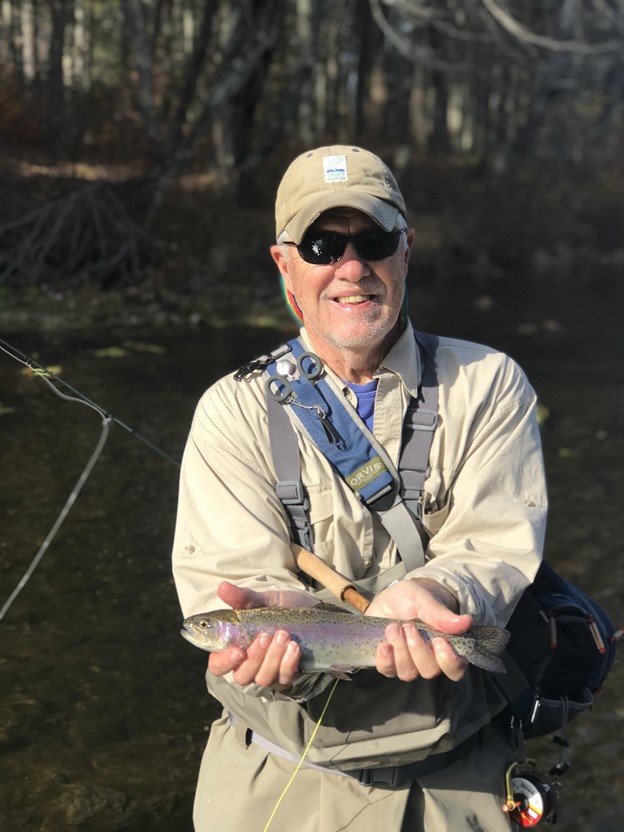WRITING ON THE FLY
By GEORGE LISET
I am not a trout snob, but they are my favorite to fish for. During the Dog Days of Summer, fly fishing for trout can be problematic, especially in Southern New Hampshire.
Trout like cold water, and the only place to find cold water that holds trout are way up north in the small spring fed streams in the White Mountains or bottom release dams in Pittsburg on the Connecticut River. There is another alternative to fly fishing rivers and that is to fly fish those trout-only ponds that are spring fed.
My fond introduction to using a float tube occurred about ten years ago when I went with my friend Charlie Croft to fly fish in Jackman, Maine, with float tubes. I grew up on the ocean and was comfortable around the water. I lifeguarded as a kid and had a boat growing up so when Charlie asked me to go I jumped at the chance. I did have some concerns.

The last time I saw someone float tubing was on an old rerun of The American Sportsman. The fly fisher was in what looked like an old tire tube with some rope tied to it to make a seat, and looked way too small. Charlie assured me his tube was like sitting in the recliner in your living room, but on the water with a fly rod. Then Charlie went on to paint this romantic picture of fishing on ponds that only Maine guides knew about. Charlie kindly left out the part about bush whacking into the pond with the float tube on your back and fighting mosquitos the size of Hummingbirds. In the end it was worth it. Charlie did not disappoint, the fishing was tremendous and I was hooked on using the float tube.
There are many great fly fishing only ponds that hold trout. Most are listed on the New Hampshire Fish and Game website. There are many with easy access for those days when your knees are aching or you just want to get on the water quickly. A few others will take some work and a little hiking to get to it which makes these ponds more desirable because they are not overfished.
Charlie taught me that some ponds are morning ponds and some are evening ponds and that you would have to fish them a few times to find out. That was unless someone gave you that information ahead of time. What made them a morning or afternoon pond was decided by when the insects were hatching and when the trout were feeding.
When fly fishing from a float tube, your best course of action was using a ten foot fly rod with a sinking line. This allowed you to get your fly down to the bottom where the trout were holding. I have success with a simple-to-tie Maple Syrup fly with a very slow retrieve. However, when the trout are rising I break out my floating fly line with my favorite dry fly and enjoy the action. Like Charlie said, it is like sitting in your recliner and fly fishing.
One of the advantages to using a float tube, and there are many, is that they are easy to transport versus a canoe or kayak, especially when trying to get to remote waters. As I mentioned, they are comfortable and stealthy. I cannot count all the wildlife I have surprised floating in my tube, and truth be known, I have been surprised quite a bit by an unsuspected beaver tail slap.
As I mentioned earlier, I am not a “trout snob.” So when my son sent me a picture of a big ol’ bass I was up for the challenge. I have the float tube all pumped up and the rods ready for a relaxing float on a pond near you.
George Liset of Dover is an award-winning outdoor writer and avid fly fisherman who shares insights of his time on the water exploring New Hampshire streams and rivers as well of those around New England. George is a graduate of Wheaton College, Illinois, and the University of New Hampshire. His column Writing on the Fly has been honored by the New England Press Association and the New Hampshire Press Association.




